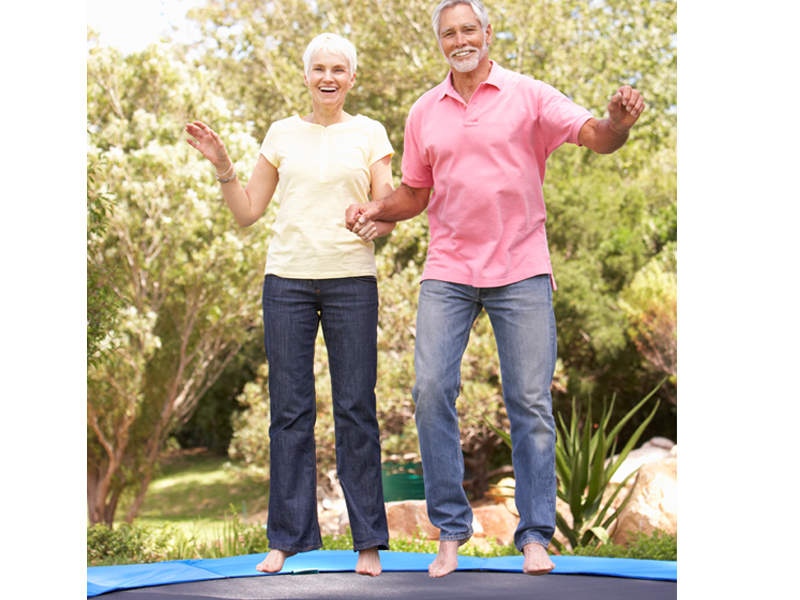Get Easy Health Digest™ in your inbox and don’t miss a thing when you subscribe today. Plus, get the free bonus report, Mother Nature’s Tips, Tricks and Remedies for Cholesterol, Blood Pressure & Blood Sugar as my way of saying welcome to the community!
The workout that’s easy on joints and hard on blood sugar and lipids

Many of us are strapped for time, so finding time for exercise is tough.
Many more are in constant pain, from issues like fibromyalgia to diabetes, where the illness itself hurts too much to exercise; yet, exercise is one of the remedies to the Illness.
So if time and pain are issues for you, you might want to consider rebounding. There are so many built-in benefits to rebounding by the simple fact of its construction, but three new studies help to showcase this exercise form’s vast benefits to health and wellness beyond a shadow of doubt…
Built-in benefits
Because rebounding is performed on a mini-trampoline (rebounder) it offers several intrinsic benefits.
First, even when simply standing on the rebounder your body must continuously fire-off different muscles in a series of contract-relax-contract to keep you from falling off balance. As such, even simple things like standing, hopping or bending while on a rebounder offer strength and balance training that you’d never get on the solid floor.
Second, rebound provides a soft and reflexive surface to exercise on. Unlike the gym floor or or other hard surfaces, rebounding is free of painful, deep impact on the joints. Each movement is soft on the joints, offering support and strength to muscles at the same time.
Exercise on the rebounder provides, in a short time, effective results for cardiovascular health, muscular endurance, improved balance and coordination, stronger legs and a tighter core. What’s more, according to the below studies, it also works effectively at lowering blood sugar, reversing type 2 diabetes and sculpting the body.
Study 1 – Rebounding and blood glucose
According to a study in the Journal of Sports Medicine and Physical Fitness, blood glucose levels respond favorable to rebounding exercise. For the study, 24 healthy adults with normal blood sugar levels were divided into two groups: 12 each in the rebounding and control groups.
The control group did not engage in exercise. The rebounding (experimental) group engaged in a 50-minute rebounding session where max heart rate was held at 70-85%. Every 15 minutes capillary blood glucose levels were measured.
The rebounding group saw impressive decreases in blood glucose levels from baseline: 26.1% reduction at 15 minutes; additional 24.2% at 30 minutes; and additional 15.7% at 45 minutes, as compared with the control group (18.8% at 15; 14.3% at 30; and 6.9% at 45).
The conclusion: “The study results provide good evidence that a prescribed exercise program on a mini-trampoline can be used for reducing blood glucose levels and thus can potentially control blood glucose.”
Study 2 – Rebounding and type 2 diabetes
According to another study, also published in the Journal of Sports Medicine and Physical Fitness, rebounding is twice as effective as running in aerobic improvements and is a high fat-burning exercise.
For this study, 60 non-insulin dependent type 2 diabetics were randomized into two 30-person groups: rebound exercise and control. The control group read health magazines or watched television while the rebound exercise group jumped on a mini-trampoline at moderate intensity for 30 minutes three times per week for 12 weeks.
Following rebounding exercise there was significant improvements in insulin resistance and lipid profile as compared with the control group. Specifically, the HDL (good cholesterol) increased while the LDL (bad cholesterol), triglycerides and insulin resistance decreased significantly from baseline.
The conclusion: “Mini-trampoline rebound exercise is beneficial for individuals with type 2 diabetes and can serve as a useful exercise approach in the management of cardiovascular risk in diabetes.”
Study 3 – Rebounding and body composition
The Journal of Sports Medicine and Physical Fitness published another study, this time looking at the effects mini-trampoline rebounding exercise program on functional parameters, body composition and quality of life in overweight women.
Here, 18 overweight women participated in the study, wherein their functional profile, strength, body composition, quality of life, and pain intensity were assessed at baseline and again after 12 weeks of rebounding exercise.
Not only were significant improvements measured in body circumferences, fat bass, lean and muscular mass, but there were also significant decreases in systolic and diastolic blood pressure values and an improvement in lipid and glucose profiles.
The conclusion: “Moderate rebounding exercise appears feasible to ensure positive effects on overall health and can be proposed to populations that could greatly benefit from training programs, such as overweight women.”
Begin rebounding today
The outcomes of these studies, plus the inherent benefits of rebounding strongly suggest that you begin this exercise method today. You can learn several ways to exercise on a rebounder in the videos in the following articles:
- Rebound for cardio fitness,
- Rebound to tone your legs and lower body,
- Easy rebound exercises for core and leg strength
- 4 ways to ‘bounce’ your way to a stronger core
Good luck and have fun getting in shape while improving your health and quality of life!
Editor’s note: Are you feeling unusually tired? You may think this is normal aging, but the problem could be your master hormone. When it’s not working, your risk of age-related diseases skyrockets. To reset what many call “the trigger for all disease” and live better, longer, click here to discover The Insulin Factor: How to Repair Your Body’s Master Controller and Conquer Chronic Disease!













